Overview
For beginners, skiing can look quite intimidating. There are so many things to note and be wary of before you begin. Are you wearing the right attire? Do you have the correct ski gear? Did you study the various techniques that let you learn how to ski properly? So many more tips and tricks to take care of.
But never fear! We know how difficult it can get, so to dispel your worries, we have created a beginner’s guide for everything skiing! From the top of those mountains to the very edges of the slope, learning to ski is good exercise, lets you enjoy nature, and is a great hobby to have!
Let us walk you through some basic skiing exercises & skills needed for the activity, with some rules and ski tips thrown into the mix!
Beginner Skier Tips on Learning How To Ski
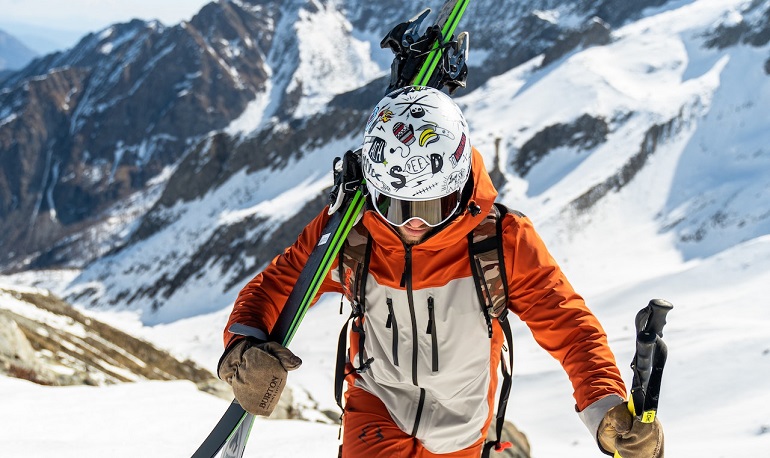
Below are 16 fundamental rules and tips we identified that all beginners could benefit from when going skiing. It doesn’t matter if you are a first-time skier or an advanced skier – revising helps everyone!
More than anything, beginner skiers should take it easy. It won’t help if you push yourself to achieve an expert level, so be comfortable and get a feel for the sport on your first day! After all, risking injury and getting hurt comes with trying to overachieve, so don’t do that now.
Below, we tackle many beginner issues, like how to layer for skiing and gear, get into good shape, study slope rules, and other general basic movements and tricks to help you out. Read on to learn more.
1. Knowing the Rules of the Slope
Before starting your ski journey, there are definitely lots of things to worry about. The primary ones include certain rules built for safety and protection because safe skiing is very important.
Most mountains, ski areas, and ski resorts have the following unspoken rules that every skier must follow, not just for their own safety, but for the safety of other skiers too.
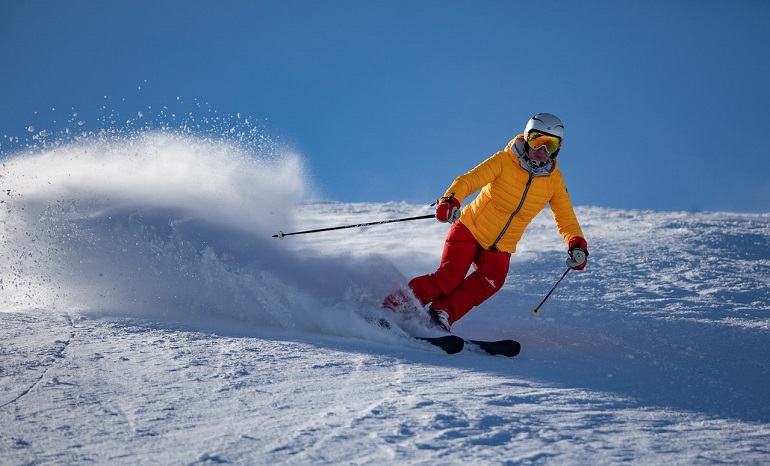
We have broken these rules down into 10 basic parts:
1. Respect your fellow skier community on the slopes! You should always be respectful of the people skiing around you. Adjust and adapt your behavior and skiing habits so as to not harm them in any way.
Remember that they are just like you, skiing either for the first time or perhaps they’ve been there longer, but they should be given due respect.
2. Keep your ski and snowboarding speeds in check! Your current skill level is very important: your skiing and snowboarding speed cannot surpass or underpass it. Learning to control your speed is key, while keeping your surroundings in mind.
This includes snow conditions, mountain depth, steeper hills, etc. So before you go on and challenge your friends (who have also just started skiing) to ski racing, get a handle on that speed before you crash into someone.
3. Make sure you know where you’re going. Mapping your trajectory is very important. We recommend keeping a ski map (also called a trail map or slope map) on you to figure out the basics of the terrain.
Also, while choosing your trajectories live while skiing, remember that the skier in front of you is the priority. This is tricky to navigate when you’re going downhill, but you should try to use your skis to choose a path that doesn’t make you bump into another skier.
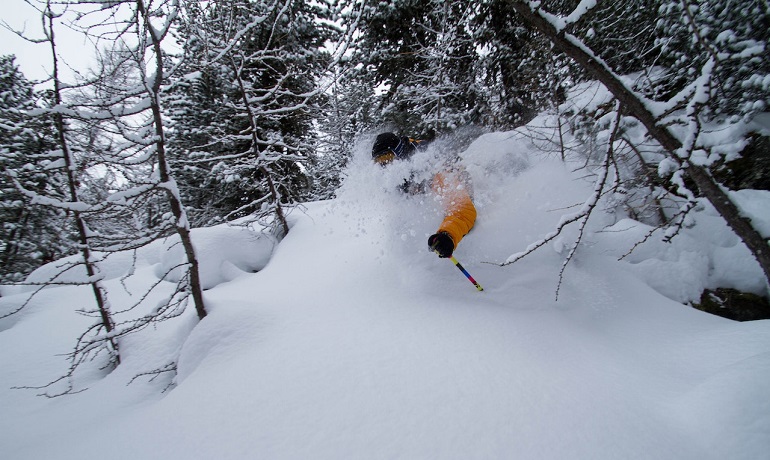
4. Be extremely careful when overtaking someone! Oftentimes, what first-time skiers end up doing is getting ambitious while overtaking another skier, and ending up injured. You should try to leave ample space for the skier you overtake so that they have enough room to keep going their way on the slope.
5. Rejoining a slope is trickier than it looks. Most of the time, skiers don’t look in all directions and end up falling over or crashing into a passing skier. You need to avoid hitting others, so be very vigilant and use your best ski poles to cross over after looking left, right, up, and down.
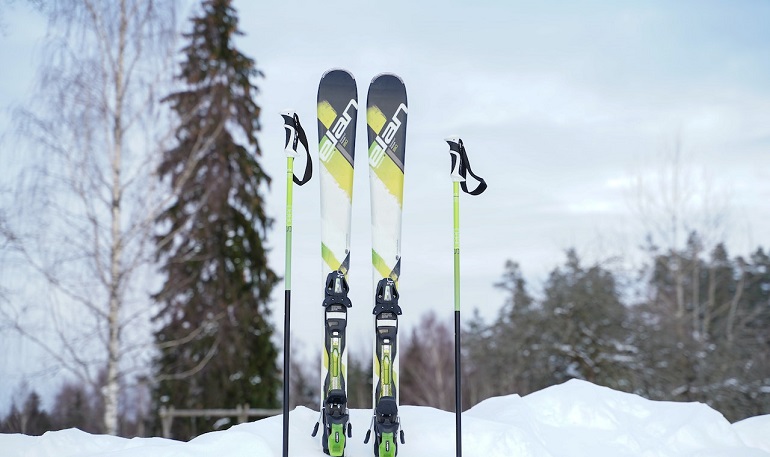
6. Learning to stop properly is among very important skills. In a groomed trail (which is a flat terrain specifically for practicing), you are not to stop in the middle. You can’t even stop at the brow of the mountain or hill, as it can cause trouble to other skiers. Thus, only stop at the very edges of the slope, if you absolutely must.
7.Doing a walk uphill or descending on foot can be confusing. Firstly, if you are a beginner, you must try to learn how to ski on short slopes rather than big ones. Secondly, if you’re walking uphill or downhill on foot, use your ski poles as guides and be sure to stay on the edges of the hill to not get in the way of others.
8. Know what the signs and markings on the hills mean! There are lots of signs placed all over the mountains and trails to let you know what they represent and if they’re a good fit for your ski level. We go over them below!
9. Learn to respond to an emergency. Accidents are very common in difficult and challenging sports like skiing. Knowing how to react when someone is hit (on the head, knees, or foot) can be a lifesaver for some.
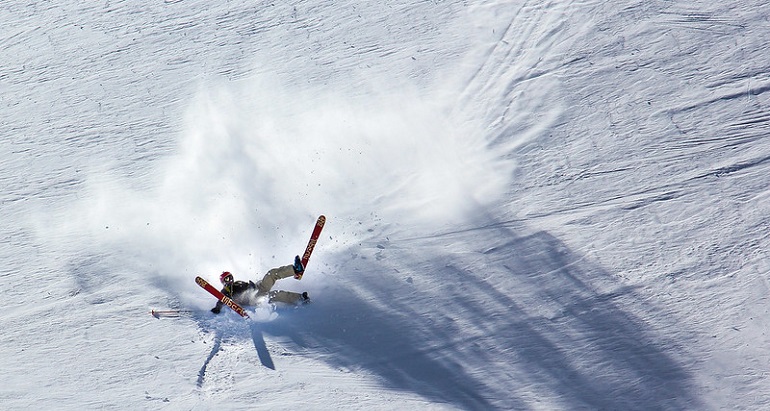
Providing assistance, like in the case of hitting the ground after a fall, is taught in ski lessons by a trained instructor.
10. Finally, carry your ID with you always! Keeping your formal identification documents with you at all times can save you during many circumstances. This includes either being in an accident yourself or witnessing one.
You may also be able to do exclusive snow activities and things like renting gear if you have your ID on you.
2. Get a Pass & Ski as Much as You Can
A ski pass is a ticket that provides proof that you have paid for the amenities offered by the ski area or resort. This includes the ski lift and the slopes themselves since using them has a charge. Depending on the type of pass you purchase, you can get yourself a day of skiing or even a week.
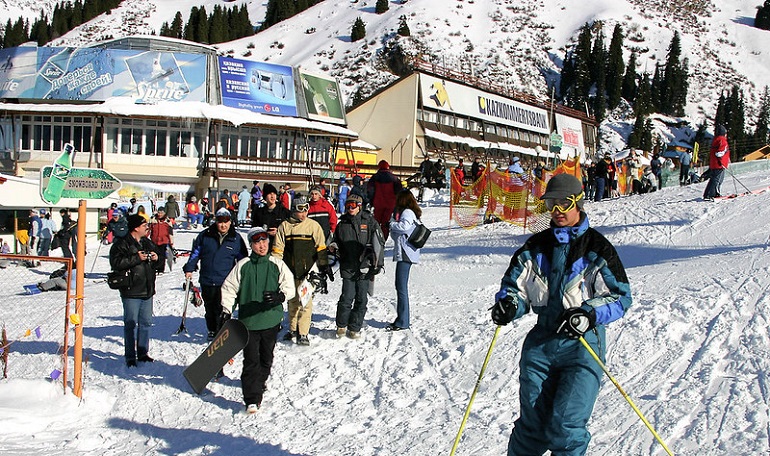
The point is that you should invest in a good one that gives you a lot of days to work with. Not only will it be good practice, but you will also find it cheaper to buy one pass that gives you a much longer skiing time than daily ski passes, which can get very expensive.
The first thing to check is the area that you like to ski in the most, and if they have local options. Check the best resorts in that area, and what partners they have. This will lead you into finding which ski resort offers the best season passes, and what they allow access to.
For personal knowledge, you must know how many days you ski, and how many you would be willing to do if you purchase a pass. Remember that per-day passes can give you very steep prices when they add up.
So it’s good to get a pass with a lot of days and ski as much as you can. Of course, this cost will be included in your budgeting plan along with travel costs, food, etc. You also need the ski’s cost before planning a ski trip.
3. Take a Lesson From Beginner Skiers
Ski lessons are so important for beginners! And who better to learn from, than your own fellow sportsmen who are new to learning the craft?
Not only will you gain confidence and see techniques others are using, but you will also figure out what things and skills work for you, and what don’t. If your friends are beginners, you can figure things out together.
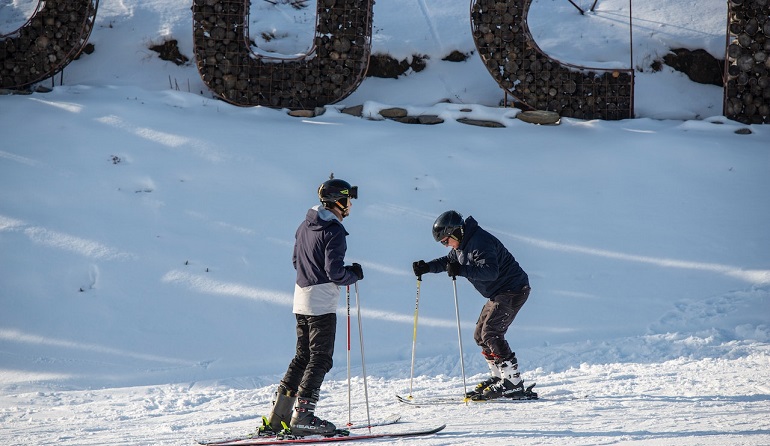
But better than learning from other starter skiers is to go ahead and take a proper lesson, taught by a licensed ski instructor. Instructors can teach you the technicalities of the sport with hands-on practice.
They will also keep you from adopting bad habits and will teach you healthy ski tips. Working your upper body and lower body in particular ways to maximize your performance is also something an instructor can help with.
Now, we know lessons can get expensive. Our solution? See if your local mountain resort has ski group lessons! Usually, they are offered to adults as well as children.
Some mountain resort areas also offer female-centric groups where women can come together and discuss beginner ski tips. They can find like-minded skiers and other women to ski with too.
Even if you have prior experience in skiing, it always helps to take a refresher course and improve your skillset using lessons. These lessons can help elevate your skillset from amateur to confident learner, and even sometimes to intermediate with enough time and practice. Finally, you can learn to ski on terrains that you might not have experienced before.
4. Buy Your Own Ski Boots and Get Them Fitted
Buying your new ski boots is very important. It is so crucial to get your ski boots fitted properly at a specialized ski shop, as uncomfortable ski boots can make or break your skiing experience.
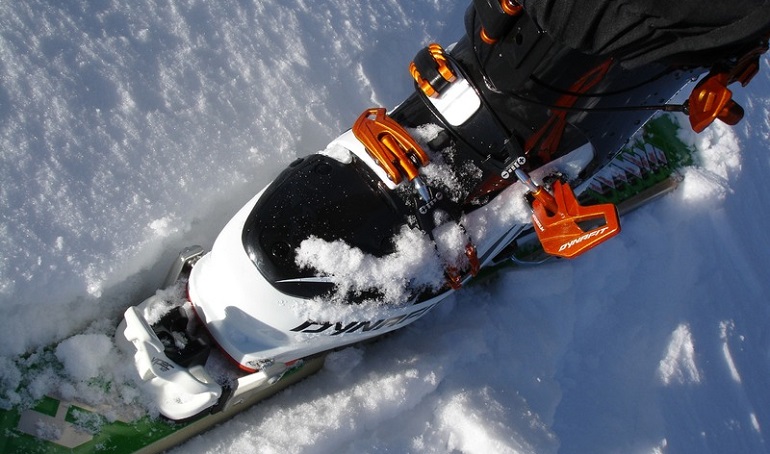
Perhaps renting boots may be a good idea too, so you can get a feel for them and try them out on the slopes immediately. But buying your own boots is important to break into them and have them completely support your foot during the activity.
Ski shops usually have a boot fitter on board, so they can help you out in making your decision and making sure your foot is perfect for the boot. A good pair of ski boots should be comfortable.
It should not be too tight on you, as that will cause pain and cold feet later on while you’re on the slopes. But they shouldn’t be too loose either. Make sure you buy a separate insole that is supportive, as the ones that come with the ski boots usually cause discomfort.
5.Rent Skis Before You Commit
At the mountain areas and resorts, there are specialty shops made to rent gear, like ski boots, ski poles, clothing items, and more importantly, skis themselves. Purchasing your gear like skis outright might not always be the best idea.
This is because equipment is expensive, and returns and exchanges are difficult. That’s why we recommend you rent your skis. Test them out, and if they suit you then buy them! However, more often than not, they are not very suited, as there are so many styles.
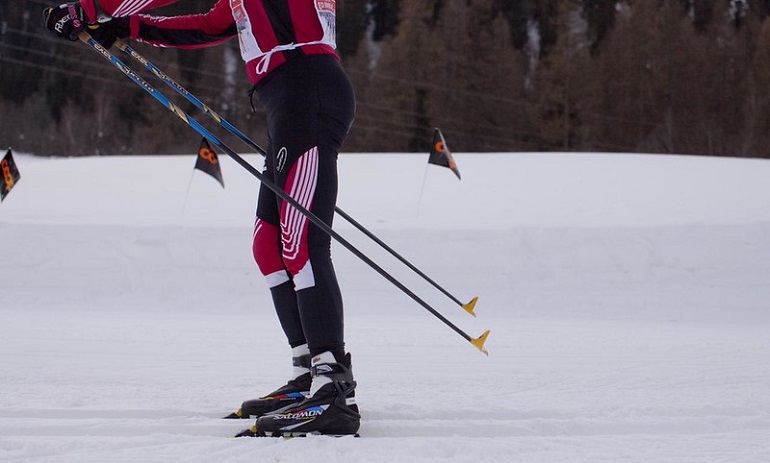
Especially as a beginner, it takes a while (sometimes a very long time) to gain familiarity with the skis. So taking your time renting and getting to know them is good. If you like them then go ahead and purchase, but if you don’t then you can always try different ones.
6. Testing Out the Bunny Slope
The bunny slope, or the bunny hill, is a very interesting name given to a very simple part of the mountain. It simply refers to a flat area with an incline on the mountain that beginner learners can go on to learn how to ski.
It is usually made for novices and amateurs, as the incline is very gentle and chances of a fall or accident are very less.

The best part is that most bunny hills and slopes usually have a designated ski instructor overlooking and helping out the skiers. There is very little challenge on a bunny hill, which makes it perfect for honing your skillset and gentle practice to get a sense of the sport.
After conquering the bunny slope, you may move on to more challenging terrains.
7. Ski With People Who Are Better Than You
This is actually a general motto for success in life! When you are surrounded by people better than you at anything, be it an activity or otherwise, chances are that you will improve. Skiing with people better than you at the activity will encourage you to push yourself to get better. They will also correct you on your bad skiing habits.
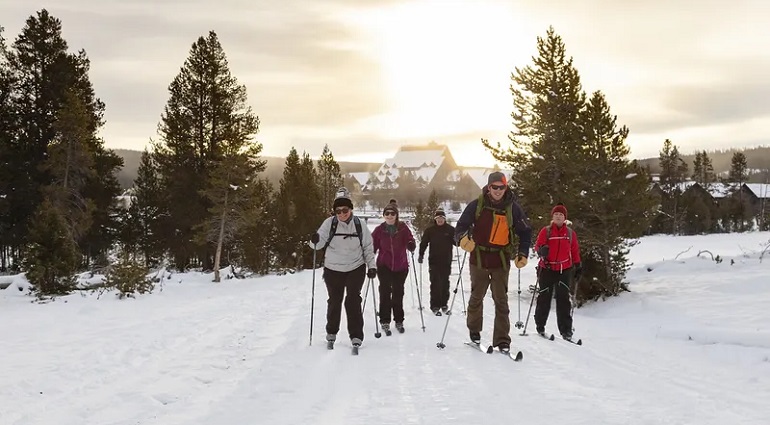
However, be sure that the people you ski with are patient and understanding, and don’t leave you behind or give up on you. They should understand your comfort level and not make you ski a terrain you are unfamiliar with, which is beyond your capabilities.
You should seek help and companionship for improvement, not unhealthy competition. You must have to carry the best ski walkie-talkies with you for unexpected emergency situations
Observe other ski players, and see what they do and how they move. This way, you may be able to understand what area to work on in your own skiing. However, if you feel discouraged by the presence of other skilled individuals around you, or don’t feel like you’re making enough progress, we have another solution for you.
8. Ski Solo
Skiing solo is great! Being able to ride the snow on your own can be liberating, and so can teaching yourself. Spending time alone on the slope is a great way to reflect on your performance. You should never be afraid to hit the snow without friends.
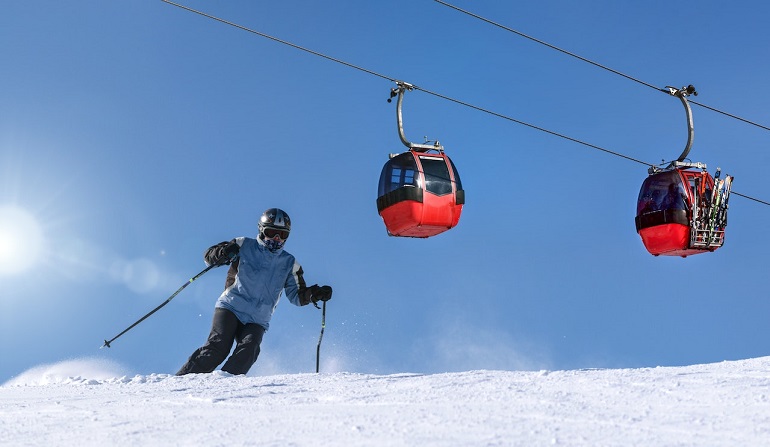
When you slide down a terrain alone, you build confidence and balance, being able to shift your weight and taking small steps to improve on your own time. When you spend time skiing solo, you can get to know what form works well for you.
You get to keep up with yourself and enjoy the ride as you go. You can even change up terrains and level up your usual route to explore more.
When you ski solo, no one will be there to witness (or laugh!) when you slip or fall, get injured, and hit your knees or head or whatever. When you mess up, it’ll be just you, so you can take the edge off and learn from your mistakes.
However, while alone, uphill ski walks might be difficult, so here are some tips. Edge your skis perpendicular and upward (90 degrees) to the hill (keeping your skis parallel), then begin to push upward sideways and take little steps. Use your ski poles to guide you.
9. Lean Forward and Be Aggressive With Your Skis
When beginner ski learners start moving, they tend to lean backward too much. This could easily lead them to lose their balance and take fall. Instructors often correct this posture by asking beginners to lean forward so they have more control over their movement.

Think of it like an ice skating movement, moving forwards with your ski pole on either side as you go. Taking turns and making a sideways slide is easier when you lean forward too.
In general, skis made for beginners are quite soft and bend easier than those for advanced skiers. So, as you improve your skillset, the softer skis will feel difficult to control for you.
So being aggressive with your movements is okay as long as you can better control yourself and your speed. It’s very easy to lose control on the fall line, but don’t let that happen.
10. Stay on the Groomers at First
Groomers are specific areas that have been flattened by machines known as snow cats. The snow there is smooth and perfect for practicing for beginners. Usually, ski resort equipment makes this possible.
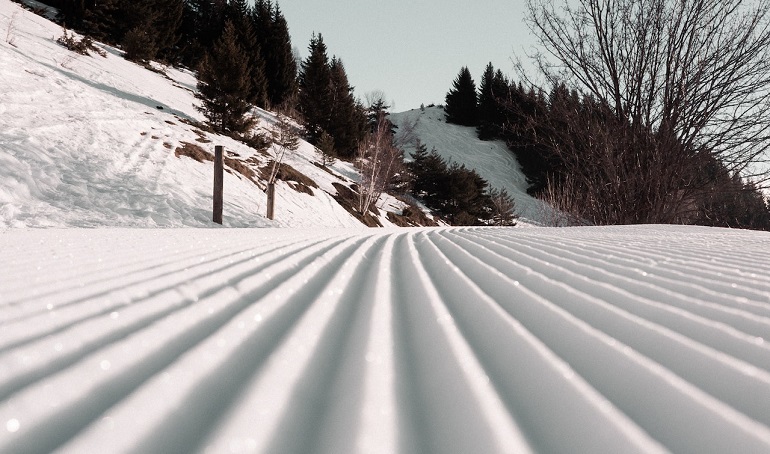
The snow on groomers is consistent, which allows for better control and a smoother slide. Beginners should keep to groomers until they are ready to ski on ungroomed runs, which are harder to control. Most people who ski learn at groomers first, then in other areas.
11. Dress Appropriately
Layering. That’s what you need to do when you plan ahead for your ski trips, keeping lots of extra layers to keep you warm. Keeping warm is key in the harsh, windy, and cold climate of the mountain. Keeping appropriately warm will allow you to focus on skiing better.
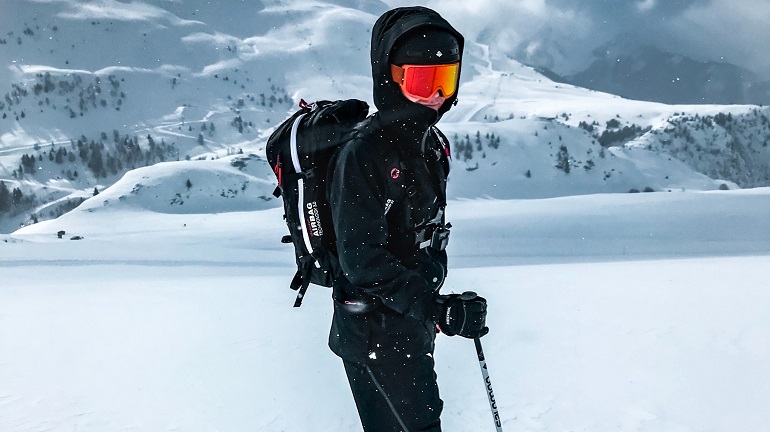
Packing an outer layer like a ski jacket is crucial. Along with that, some snow pants/ski pants and wool ski socks are great to have to keep those toes insulated. Make these layers waterproof too, to keep from getting wet.
12. Work on Building Leg Strength
Your quads and calve muscles are the main source of your skiing power. Your lower leg anatomy gives you endurance for skiing and getting as many runs as you might want.
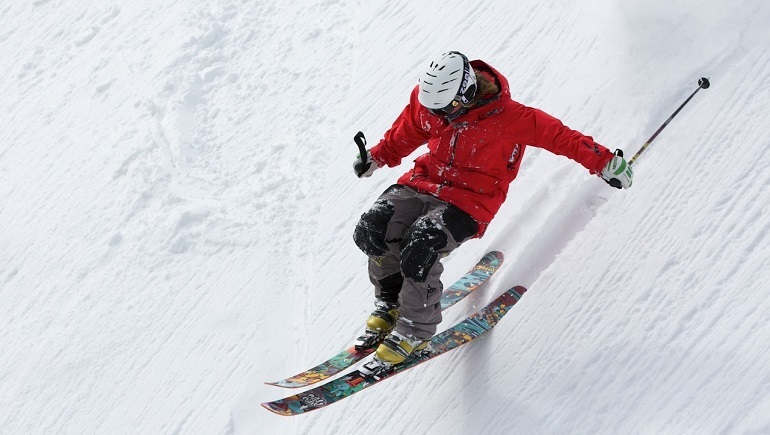
Building these muscles is crucial. We don’t mean going crazy with leg days just for a few days on the snowy slopes. Rather, simple squats and lunges daily can do the trick. And if you’re not a gym lover, then simply take the stairs over the elevator for a similar result.
These leg muscles will hold you up to stand on any slope you decide to go down. So, developing them will improve your skiing capability greatly. Stretching is important too. Try yoga to build dexterity in muscles and loosen yourself for any terrain you choose.
13. Know How to Read Ski Symbols
There are several symbols and signs on mountain slopes, signifying the difficulty ratings of the slopes you are skiing on.
The green circle stands for beginner-level slopes. These runs have a grade of less than 25% (100% grade means an incline of 45 degrees) and are groomed. This means they are perfect for beginner skiers.
The blue square means an intermediate terrain. Blue runs have a grade between 25% and 40%. They are groomed but are steeper and narrower than a green run.
Single black diamond and double black diamond runs are made for advanced ski experts and experienced players who are looking for a challenge. These have grades of more than 40% and are quite inclined and difficult to manage unless you are very skilled.
14. Know the Differences Between Skis
Skis come in all different shapes and sizes. You have to find the ski type that works best for you. It can be a combination of shapes, like a rocker-camber ski, or a rocker-only or camber-only ski too.
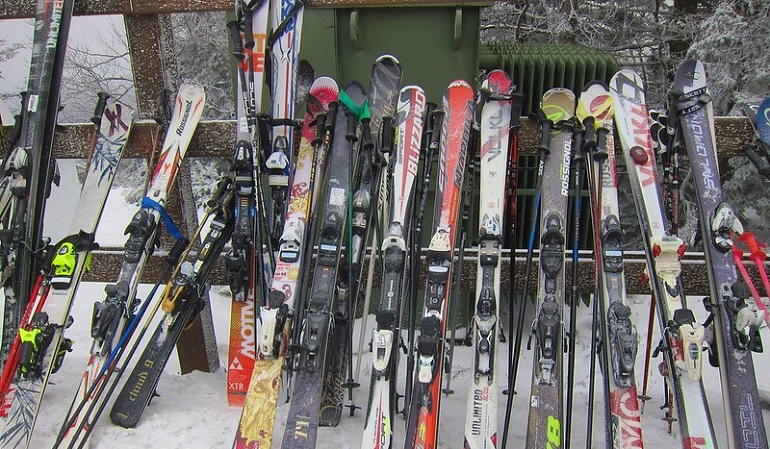
As mentioned before, we recommend renting skis and testing them out before making the purchase. However, for beginners, usually, rocker skis are best. Read up on them more when you plan your ski trip & which ski country is great for you.
15. Learn How to Use the Ski Lift
There are two types of chairlifts for which lift tickets can be bought and used: T-Bar style and Button lifts. Knowing how to get on them and off is very important, since if you don’t know how to use them properly, you may get injured or fall.
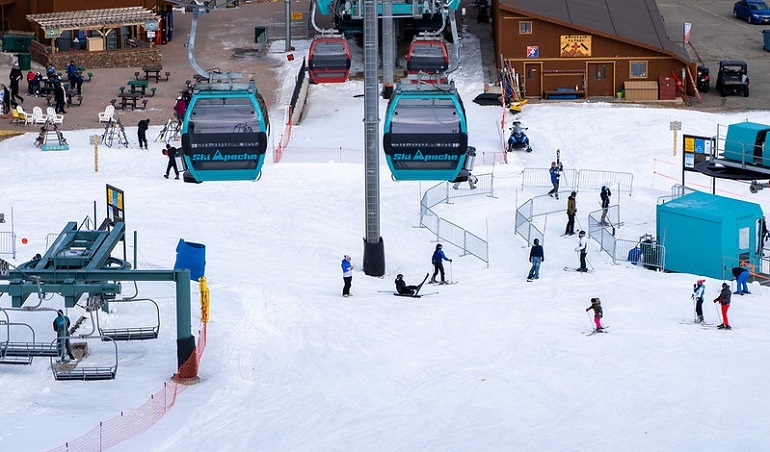
To get on a T-Bar chairlift, push forward, keeping your ski pole in one hand. Look over one shoulder, and when the ski lift chair reaches you, sit on it and put the safety bar on, and enjoy the ride.
To get off, put your poles in one hand, and lift the safety bar with the other. Lean back so you don’t fall forward, and downhill ski gently.
For the button chairlift, the procedure is slightly different. After buying your lift ticket, put your poles in one hand, and point your skis in the lift’s direction. Look back at where the lift is coming from.
Reach out to grab the lift, hold it, and put it between your legs. Then it will guide you uphill. When you reach the top, simply let go of the bar and ski off to the side.
16. Don’t Carry a Backpack
It might be tempting to take that backpack with you with all your things, but leave it at the ski resort! Backpacks can be dangerous because they are heavy, so they can bog down your control and speed. They can also get caught on chairlifts when you are getting off, which can be very dangerous and can cause harm.
Conclusion
Learning to ski takes a lot of time, patience, and effort. We hope that this beginner’s guide helped you in learning how to ski, including some tips and tricks not many know about.
Going into skiing with full knowledge of what to expect always helps. Remember to stay hydrated, keep warm and cozy, and practice hard.
Happy skiing!